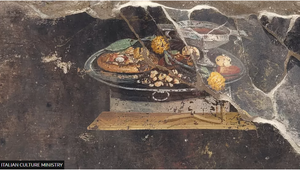2000 year old pizza: Difference between revisions
(Created page with " <!-- seo --> {{#seo: |title=The pizza could be 2000 years old |titlemode=replace |description=A fresco of a 2000 yea old pizza has been discovered in Pompeii }} <!-- /seo -->...") |
No edit summary |
||
| Line 10: | Line 10: | ||
{{Template:PageAwaitingImage}} | {{Template:PageAwaitingImage}} | ||
A painting discovered by archaeologists in the ancient Roman city of Pompeii may depict an early version of the Italian pizza, according to Italy's culture ministry. The 2,000-year-old fresco, found in a house near a bakery during recent excavations, showcases a flatbread that could be considered a precursor to the modern dish. However, it lacks the traditional ingredients that officially classify it as a pizza. The fresco was unearthed this year during new digs in Regio IX, one of Pompeii's nine districts. The excavation work, which resumed after a partial exploration in the 19th Century, took place nearly two millennia after the city was covered in volcanic ash from the eruption of Mount Vesuvius. Experts at the Unesco World Heritage site speculate that the depicted flatbread might have been consumed with fruits like pomegranates or dates, or garnished with spices and a type of pesto sauce. Gabriel Zuchtriegel, the director of Pompeii, noted the contrast in the painting between a modest and simple meal and the opulence of silver trays. Zuchtriegel drew parallels between the ancient dish and the evolution of pizza, which originated as a humble Southern Italian cuisine and has now gained global popularity, even gracing the menus of prestigious restaurants | A painting discovered by archaeologists in the ancient Roman city of Pompeii may depict an early version of the Italian pizza, according to Italy's culture ministry. | ||
The 2,000-year-old fresco, found in a house near a bakery during recent excavations, showcases a flatbread that could be considered a precursor to the modern dish. However, it lacks the traditional ingredients that officially classify it as a pizza. The fresco was unearthed this year during new digs in Regio IX, one of Pompeii's nine districts. | |||
The excavation work, which resumed after a partial exploration in the 19th Century, took place nearly two millennia after the city was covered in volcanic ash from the eruption of Mount Vesuvius. Experts at the Unesco World Heritage site speculate that the depicted flatbread might have been consumed with fruits like pomegranates or dates, or garnished with spices and a type of pesto sauce. Gabriel Zuchtriegel, the director of Pompeii, noted the contrast in the painting between a modest and simple meal and the opulence of silver trays. Zuchtriegel drew parallels between the ancient dish and the evolution of pizza, which originated as a humble Southern Italian cuisine and has now gained global popularity, even gracing the menus of prestigious restaurants | |||
Additionally, near the bakery's oven, archaeologists discovered the remains of three individuals in the working areas of the house. The eruption of Mount Vesuvius in AD 79 enveloped Pompeii in ash, preserving the city and its inhabitants over time. | |||
Since its discovery in the 16th Century, Pompeii has provided archaeologists with valuable insights. The site is located approximately 23 km (14 miles) from Naples, the present-day hub of authentic Italian pizza, safeguarded by Unesco. | |||
{{CategoryLine}} | {{CategoryLine}} | ||
[[Category:Ingredients]] | [[Category:Ingredients]] | ||
[[Category:Prepared foods]] | [[Category:Prepared foods]] | ||
Revision as of 16:18, 27 June 2023

A painting discovered by archaeologists in the ancient Roman city of Pompeii may depict an early version of the Italian pizza, according to Italy's culture ministry.
The 2,000-year-old fresco, found in a house near a bakery during recent excavations, showcases a flatbread that could be considered a precursor to the modern dish. However, it lacks the traditional ingredients that officially classify it as a pizza. The fresco was unearthed this year during new digs in Regio IX, one of Pompeii's nine districts.
The excavation work, which resumed after a partial exploration in the 19th Century, took place nearly two millennia after the city was covered in volcanic ash from the eruption of Mount Vesuvius. Experts at the Unesco World Heritage site speculate that the depicted flatbread might have been consumed with fruits like pomegranates or dates, or garnished with spices and a type of pesto sauce. Gabriel Zuchtriegel, the director of Pompeii, noted the contrast in the painting between a modest and simple meal and the opulence of silver trays. Zuchtriegel drew parallels between the ancient dish and the evolution of pizza, which originated as a humble Southern Italian cuisine and has now gained global popularity, even gracing the menus of prestigious restaurants
Additionally, near the bakery's oven, archaeologists discovered the remains of three individuals in the working areas of the house. The eruption of Mount Vesuvius in AD 79 enveloped Pompeii in ash, preserving the city and its inhabitants over time.
Since its discovery in the 16th Century, Pompeii has provided archaeologists with valuable insights. The site is located approximately 23 km (14 miles) from Naples, the present-day hub of authentic Italian pizza, safeguarded by Unesco.